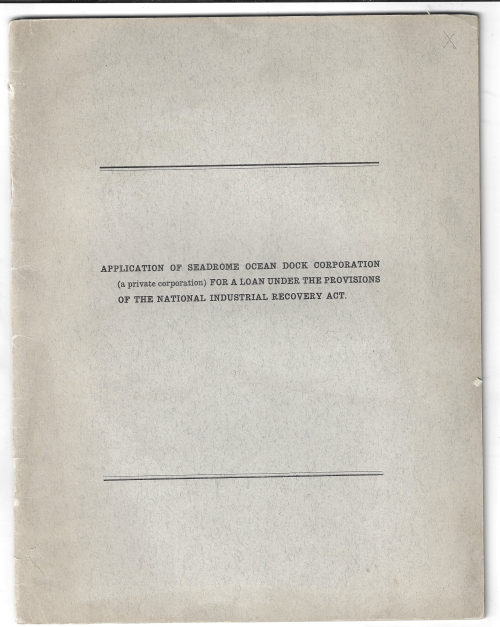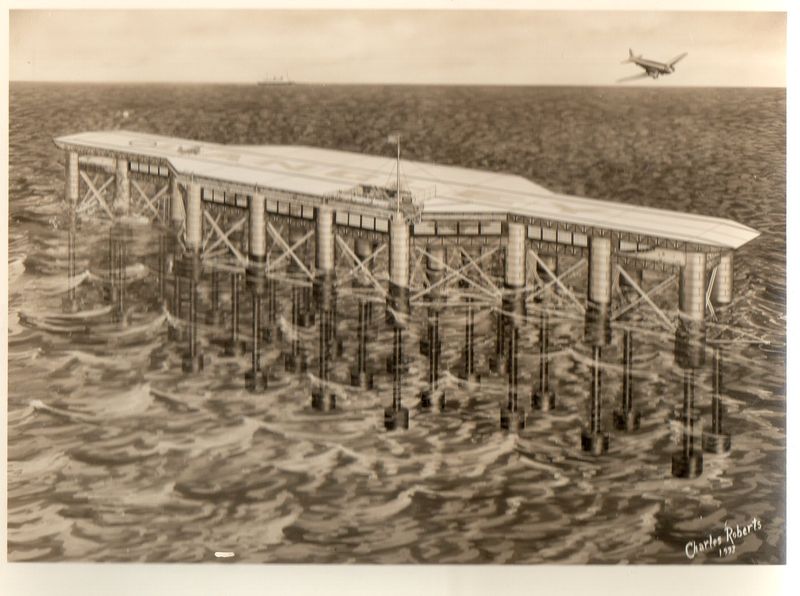 This interesting and exploratory pamphlet, Application of Seadrome Ocean Dock Corporation (a private corporation) for a Loan Under the Provisions of the National Industrial Recovery (1933) was the result of the work of Edward R. Armstrong (1880-1955), and proposed a series of floating airports to facilitate transatlantic flights.
This interesting and exploratory pamphlet, Application of Seadrome Ocean Dock Corporation (a private corporation) for a Loan Under the Provisions of the National Industrial Recovery (1933) was the result of the work of Edward R. Armstrong (1880-1955), and proposed a series of floating airports to facilitate transatlantic flights.
The outline for this plan asks the federal government for a loan of $30 million (Depression) dollars to undertake the construction of a five floating airports transoceanic network. "It will require the work of approximately 10,000 men per month for a period of twenty-four to thirty months". The labor figures did not include was what necessary to produce all of the material necessary for the project ( for reasons unknown). Once finished the network would enable aircraft to make it across the ocean in 18 to 36 hours.
The members of the Seadrome Corporation estimated that the entire 30 million would be paid back by 1945, and that the corporation would be completely debt-free. Perhaps all of this made sense when Armstrong first developed the plan in 1913, just ten years after the Wright brothers' successful first in North Carolina. The idea of the floating airport girding the Atlantic was a pretty interesting idea, seeing as how the world record for sustained non-stop flight in 1913 was 11 hours (in a Maurice Farman MF-2), and that was under more-or-less optimal conditions; the speed record was 120mph, and again, optimal conditions and not sustained for hours on end. By 1933 it seems to me that it had become obvious that non-stop transoceanic flight was coming, and coming soon. That would of course make an investment in the Seadrome project superfluous, like building an antique, though an unnecessary one. The first transatlantic non-stop flight was made by John Alcock and Arthur W. Brown in 1919, averaging about 100mph; Lindbergh would come later to accomplish the first solo non-stop in 1927--by the early 1950's jet aircraft would be making the trip with regularity, which means that for most of the life of the completed Seadrome it would have been unnecessary. I feel certain that the Seadrome--which was supposed to be paid off by 1945, though in 1933 there was no inkling on the part of the Corporation members who wrote the request for the money that a war was looming and that there would have been almost no way for them to have been made at any time between 1939 and 1945--would never have been paid for.Armstrong’s idea would get major play in the popular press from time-to-time, and discussed as a series of floating islands. Armstrong himself would organize the Seadrome Ocean Dock Corp. in the late 1930’s, his pretty but impractical idea (reported by Time Magazine1 in 1933 as little more than “a perennial gift to Sunday feature editors”) finally grinding to a salty end with greater fuel capacity and efficiency in transatlantic aircraft.
As I said, this idea seemed pretty good when it was shiny and new, but less so as time went on and aircraft became larger, more powerful, and more efficient, capable of making the trip on their own. 
Time magazine; October 28, 1929; Seadrome.
- "Although rain was beating down on Cambridge, Maryland, last week, men enthusiastically lugged into the Choptank River a one-ton steel model of the steel islands (seadromes) which Edward R. Armstrong of Holly Oak, Delaware, proposes to anchor 375 miles apart across the Atlantic. The model, 1/32 the size of intended seadromes, consists essentially of a rectangular platform. To its underside are attached hollow steel columns, each ending in a circular disk. Air in the cylinders was sufficient to keep the device floating on the Choptank and the platform several feet above the water. Speedboats dashed around the model. Their waves did not touch the platform nor did they rock it. The heavy horizontal disks at the lower ends of the hollow columns, below the depths to which the wave actions reached, counterbalanced all surface disturbances. No surprise was his model's success to Mr. Armstrong, swarthy engineer, who since he left the Navy has been consulting engineer for the E. I. duPont de Nemours & Co. at Wilmington. For 16 years he has been experimenting and designing such a sea base having in mind ocean way stations for ships and, more lately for transoceanic aircraft. He "sold" his idea to the eminently practical duPont and General Motors financiers. They have provided him one and three quarters million dollars to build his first seadrome. Construction has already started on it. It will be called the Langley after the late Samuel Pierpont Langley, designer of the plane which, except for accidents, might have flown before the Wrights' plane did in 1903. The Langley will have an unobstructed airplane runway 1,200 ft. long by 200 ft. wide. At the mid-sides the platform will project to give room for a hotel (with restaurant and bar), hangars, storage sheds, weather bureau, offices, hospital wards, lighthouse. Platform and buildings will be 80 ft. above calm water level. Because no Atlantic waves have ever been seen more than 45 ft. high, it is improbable that the runway ever will be awash. The buoyancy columns with their stabilizing disks will reach 160 ft. below water level. That is considerably deeper than any wave action has ever been noted. Mr. Armstrong has long planned to anchor his first full-size seadrome midway between Manhattan and Bermuda. Studying hydrographic charts of the region he figured that there must exist a high spot on the ocean floor about where he would like it. He asked Secretary of the Navy Charles Francis Adams to send a survey ship to check his calculations. He was right. The survey showed a little plateau just 400 miles from Manhattan and 375 miles from Bermuda, in an almost direct line. It is six miles long by four miles wide and only two miles below sea level, whereas the surrounding ocean is three to four miles deep. The difference in depth means thousands of dollars of savings to Mr. Armstrong and his financiers on the 3½ inch steel cable he is having laid to hold his floating island to its anchors. Those anchors are to be huge round bobbins which will dig into red clay of the submerged plateau and hold the seadrome from drifting. By next fall and before Bermuda's 1930-1931 tourist season begins Mr. Armstrong expects to have the Langley completed and anchored in place, ready to receive tourist planes and to entertain travelers on man's newest conquest of an element. As the operation of the Langley makes money, he will (and he has the money in provision to do so) construct eight similar seadromes to be strung 375 miles apart between the 35th and 40th parallels, north latitude, between Long Island and Plymouth. The 375 miles is an easy jump for any plane. Hence the project presages safe and convenient airplane passage across the ocean, direct competition with both sea ships and air ships. Flying time between the continents, Mr. Armstrong calculates, will be as low as 20 hours."
- "A perennial gift to Sunday feature editors for the last five years has been the Armstrong Seadrome, vividly imaginative project for a chain of floating airports across the Atlantic. The perfect publicity subject, it offered serious readers masses of data on construction of huge platforms, stabilized high above the waves by means of weighted pillars, on problems of anchorage, navigation, operation, economics. For gumchewers there were exciting pictures of a seadrome at night, in midocean position, with flags flying, floodlights blazing, beacons stabbing the dark sky, gorgeous express planes gliding down to safe landings. Even the windows of the drome's elegant hotel underlying the deck were pricked out with cozy lights. Last week the Armstrong Seadrome leaped out of its accustomed setting in the feature supplements to land on page one of the nation's press when the Federal Government indicated that it was ready to help finance the project, that it might even build and operate the whole system itself. Money. For weeks Inventor Edward R. Armstrong & backers have been trying to borrow $30,000,000 from Public Works Administration to build five seadromes and string them out to Spain by way of the Azores. Aside from obvious national advantages to the U. S. the application cited such claims as: Construction and installation jobs would employ 10,000 men for two years. Required would be 125.000 tons of steel, five miles of anchor chain, 45 miles of cable, five 1,500-ton anchors, large quantities of electric equipment, radio apparatus, beacons, pipe, fittings, etc., etc. Airline operators would order $10,000,000 worth of new planes for trans-atlantic service as soon as work was begun on the dromes. Yearly operating cost of the five dromes, including overhead: $2,250,000. Yearly income after the fifth year would total $11.418,000, to be derived as follows: mail, $6,000,000; express, $105,000; passengers, $4,538,000; hotels, shops, concessions, hangar space, fuel & oil, $775.000. The system would collect $70 from each transatlantic fare (estimated at $350), $25 from each traveller to Bermuda, $10 from each week-end drome visitor. At first Inventor Armstrong hoped to finance his scheme with private capital. The du Fonts, for whom he used to work as a consulting engineer, helped him in his early researches. He expected substantial backing also from General Motors until Depression upset his plans. Last March he organized Seadrome Ocean Dock Corp., with himself as president and majority stockholder. His backers include GM's Board Chairman Lammot du Pont and President John Howard Pew of Sun Oil Company."


Comments